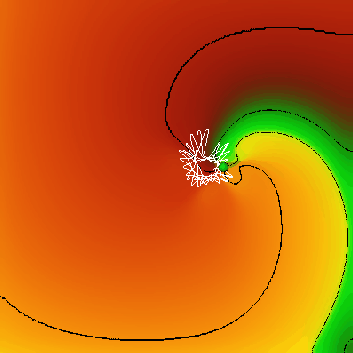


Next: Scroll
Waves and Their Up: A
Three-Dimensional Autowave Turbulence Previous: A
Three-Dimensional Autowave Turbulence
Introduction
The purpose of this paper is to describe basic features of the phenomenon
of three-dimensional autowave (AW) turbulence. This interesting phenomenon
provides an instructive example of spatio-temporal chaos, and may have
useful applications. We believe that it deserves a peer study.
Turbulence is a term from hydrodynamics and so using it for autowave
media is, of course, a metaphora. We use it to stress the essential properties
of the phenomenon in question:
-
It means complicated, apparently chaotic, spatio-temporal behaviour,
-
The complexity of behaviour grows with the size of the system, with
other parameters unchanged,
-
It is related to vortex-like activity,
-
It is essentially a three-dimensional behaviour, qualitatively different
from whatever may happen in the same system in two dimensions (hydrodynamists
agree that `real' turbulence is essentially three-dimensional, unlike `weak'
2-D turbulence).
An AW medium is a 1 to 3-D continuum of points each exhibiting a special
sort of nonlinear kinetics, and linked together via a diffusion-type process.
These properties enable non-decaying propagation of nonlinear waves, called
autowaves, which have their own inherent amplitude and form. At appropriate
initial conditions, the autowaves may form `AW vortices' which have the
form of spiral waves in two dimensions or scroll waves in three dimensions.
These interesting classes of nonlinear waves were first observed in the
Belousov-Zhabotinsky reaction [Zaikin & Zhabotinsky, 1970;
Winfree, 1973], where the aforementioned nonlinear
kinetics are autocatalytic oxidation of malonic acid. Since then, AW vortices
were observed experimentally and predicted theoretically in a wide variety
of systems of different physical nature [Swinney & Krinsky, 1991;
Holden et al., 1991; Brindley &
Gray, 1994]. A very important example is
cardiac tissue [Gray & Jalife, 1996],
where the nonlinear kinetics are the excitation (electric depolarisation)
and recovery of cardiocytes' membranes, and the diffusion-like process
is inter-cellular electric conductivity. AW media are most often described
in terms of `reaction-diffusion' equations,

where  ,
,  , are concentrations of reagents,
, are concentrations of reagents,  , f(u) are reaction rates and
, f(u) are reaction rates and  is the matrix of diffusion coefficients. One of the `basic' AW models is
the FitzHugh-Nagumo system of equations (FHN). In the form proposed by
Winfree [1991] it reads
is the matrix of diffusion coefficients. One of the `basic' AW models is
the FitzHugh-Nagumo system of equations (FHN). In the form proposed by
Winfree [1991] it reads

where u(x,y,z,t) and v(x,y,z,t)
are the dynamic variables and  ,
,  and
and  are constant parameters of the medium. Spiral wave solution for a biophysically
detailed model of ventricular excitation is shown in Fig. 1.
are constant parameters of the medium. Spiral wave solution for a biophysically
detailed model of ventricular excitation is shown in Fig. 1.

Figure 1: Snapshot of the spiral wave in a model of ventricular
tissue of guinea pig (details described in Biktashev & Holden [1996]).
Red component of colour coding shows the value of the transmembrane voltage,
and green component that of one of the recovery variables. Two isolines
of these two variables are shown in black. The blue ball at their intersection
is the spiral tip. The blue line shows its trajectory over last few rotations.
The spiral rotates counterclockwise, the rotation is not stationary but
`meandering'.
The whole picture rotates counterclockwise around a region called core
of the spiral. Far from the core, normal autowaves propagate formed approximately
in the shape of an Archimedean spiral; within the core the behaviour is
more complicated. The core may be defined as the region circumscribed by
the tip of the spiral. The tip may be defined as the point where the propagation
wavefront ends meeting the `waveback', or as an intersection point of two
isolines, as in Fig. 1. As it is seen
in the figure, the behaviour of the tip may be complicated, -- the so called
meander. FHN model is a rough caricature of the ventricular model shown
in this picture, which, in turn is a simplification of the reality, as
it ignores completely the nontrivial spatial structure of the tissue. Nevertheless,
during last 35 years, FHN model and its modifications were the most powerful
heuristic tool for understanding the reentrant cardiac arrhythmias.



Next: Scroll
Waves and Their Up: A
Three-Dimensional Autowave Turbulence Previous: A
Three-Dimensional Autowave Turbulence
Vadim Biktashev
Fri Mar 20 12:57:08 GMT 1998
![]() ,
, ![]() , are concentrations of reagents,
, are concentrations of reagents, ![]() , f(u) are reaction rates and
, f(u) are reaction rates and ![]() is the matrix of diffusion coefficients. One of the `basic' AW models is
the FitzHugh-Nagumo system of equations (FHN). In the form proposed by
Winfree [1991] it reads
is the matrix of diffusion coefficients. One of the `basic' AW models is
the FitzHugh-Nagumo system of equations (FHN). In the form proposed by
Winfree [1991] it reads
![]() ,
, ![]() and
and ![]() are constant parameters of the medium. Spiral wave solution for a biophysically
detailed model of ventricular excitation is shown in Fig. 1.
are constant parameters of the medium. Spiral wave solution for a biophysically
detailed model of ventricular excitation is shown in Fig. 1.
